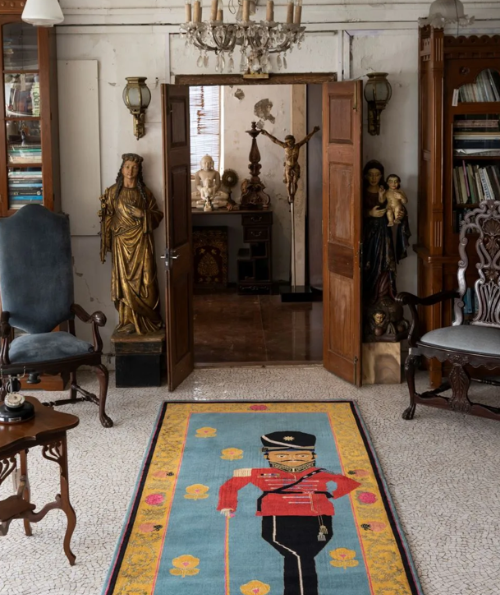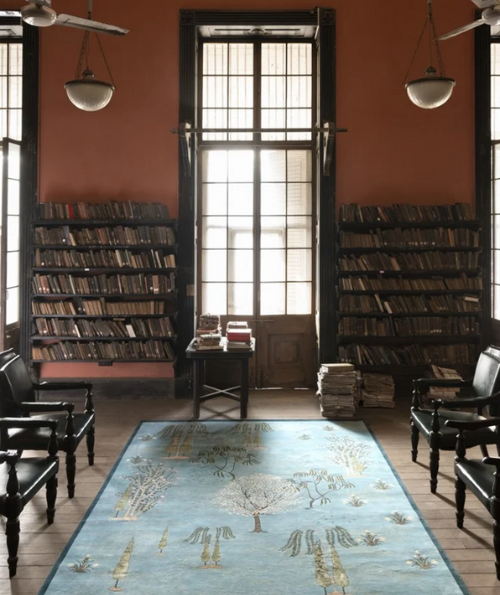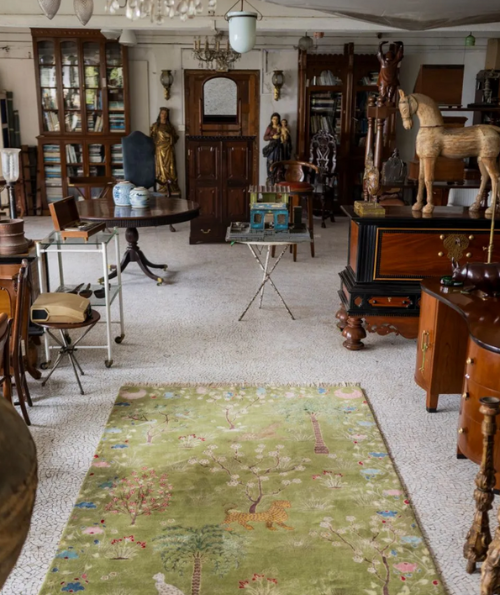“Design is something to be savoured, and not to be devoured.” – Pavitra Rajaram
The world of art and design often sees remarkable collaborations that bring together creative minds to produce extraordinary works. One such collaboration that has captivated the world of interior design is the partnership between Jaipur Rugs and AD 100 Designer, Pavitra Rajaram. Through their shared passion for aesthetics, craftsmanship, and innovation, Jaipur Rugs and Pavitra Rajaram have seamlessly blended their talents to create exquisite pieces that redefine the concept of luxury in the realm of rugs.

The collaboration titled ‘Majnun’ is a visual treat in its very essence, resulting in an array of stunning rugs. Rajaram’s designs reinterpret classic motifs including but not restricted to the Shikargah from English country homes, to the mesmerizing tantric tiger rugs of Tibet to the weeping willow motif of Chinese scroll paintings and the folk tradition of Afghan war carpets; each of these weaved carefully with contemporary sensibilities. Launched at Salone del Mobile 2023, the collection boasts rich craftsmanship, artistic curation and a commitment towards a greater good.

This collection by Rajaram, led by the Gandhi of carpets, Nand Kishore Chaudhary is knowledgeable and heartwarming. Rajaram mentions, “A chance meeting with the founder of Jaipur Rugs NK Chaudhary inspired me. I was stuck with his vision of empowering artisans to become artists. I loved his idea that each carpet is woven with the blessing of a family. When I visited the Weaver communities and witnessed the change at the grassroots, it really moved me. I wanted to be a part of this amazing ecosystem and be energized through a collaboration that was a dialogue between my design sensibilities and their artistry.”

Created in collaboration with Jaipur Rugs, the collection embodies the essence of five distinctive carpet traditions, presenting them through a modern perspective. Crafted from wool, silk, and cotton, the collection pays tribute to these traditions while infusing them with contemporary elements. The standout piece among the five is “Sipahi,” a lively rug that portrays an elegantly attired soldier surrounded by delicate floral motifs in soft pastel hues. This design draws inspiration from Afghan war rugs, which served as a departure from the aristocratic origins of most carpet traditions. Originating from North Afghanistan and parts of Pakistan, these rugs gained popularity after the Soviet invasion in 1979, as they depicted symbols of violence juxtaposed with exquisite artistry. Pavitra Rajaram, the designer, emphasizes the power of design as a historical record and admires the transformation of a painful history into beautiful works of art.

Another rug in the collection, “Sakya” represents the meditative state of a Buddhist monk, with the tiger motif symbolizing enlightenment in Tibetan culture. “Maryul,” on the other hand, transports us to 17th-century Ladakh, where a treaty involving the Tibetans, Mughals, and the Namgyal ruler resulted in the creation of the Yarkandi design. This geometric pattern reflects the fusion of all three cultures. Additionally, “Arjumand” takes inspiration from traditional Persian designs found in the Mughal gardens of Kashmir, incorporating elements influenced by Chinese scroll paintings. Rajaram explains that the entire collection is named after the weeping willow, also known as the Bid Majnun, which symbolizes a passionate lover—a reflection of her deep affection for carpets.

Pavitra Rajaram drew her inspiration for the Majnun Collection from the rich craft traditions spanning across the geographical regions from Persia to China. Her focus was not only on the designs themselves but also on the stories of the artisans and the cultural context in which these traditions emerged. The collection serves as a celebration of iconic carpet traditions, reimagined and presented in a contemporary idiom. Each carpet in the collection has its unique design approach, requiring innovative techniques and adaptations in both technique and design.

The rugs created through this collaboration feature vibrant colours, intricate motifs, and contemporary patterns that breathe new life into age-old traditions. Rajaram explains that the motifs featured on the carpets have a significant place in design history, having been present in various objects, textiles, collectables, and artefacts throughout time. By incorporating these motifs into the collection, Rajaram pays homage to the rich design heritage that has been passed down through generations.

Each design tells a unique story, from the Afghan war rugs to the Yarkandi pattern and the symbolism of the weeping willow. Their rugs have become highly sought-after pieces for designers and homeowners looking to add a touch of luxury and sophistication to their spaces. The collection showcases the power of design to transcend time and capture the essence of diverse cultures, ultimately leaving a lasting impression on those who appreciate the artistry of carpets. The fusion of tradition and contemporary design has made these rugs versatile, fitting seamlessly into various interior styles, from classic to modern and everything in between.

An empowering dialogue between Rajaram’s design sensibilities and the craftsmanship of the weavers over at Jaipur Rugs, each carpet tells a tale as old as time. A tale of history and legacy articulated magnificently through Rajaram’s creative sense. An epitome of quality, artistry and elegance, each of these rugs is a conversation starter and stands as a testament to the power of artistic partnerships. Their collaboration has redefined the possibilities in rug making, inspiring a new generation of designers and leaving an indelible mark on the world of interior design.


